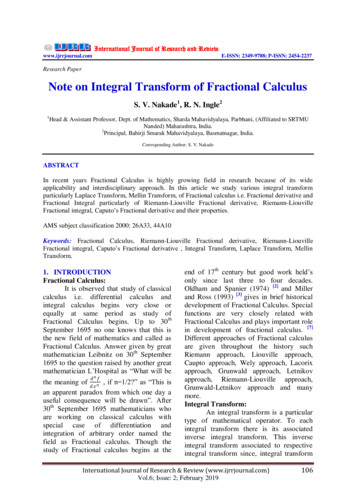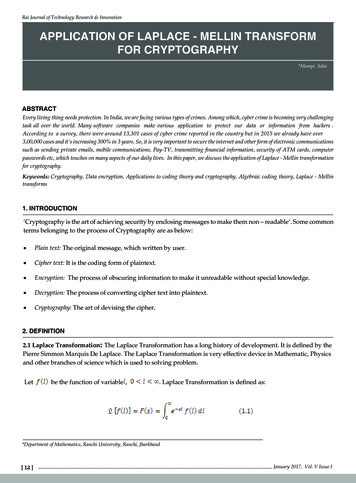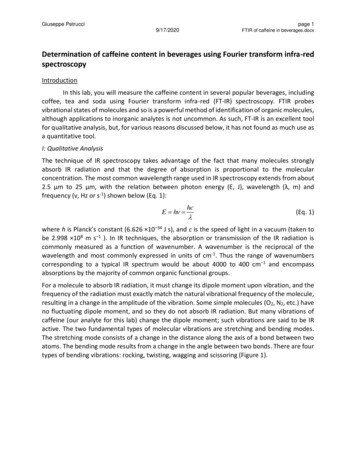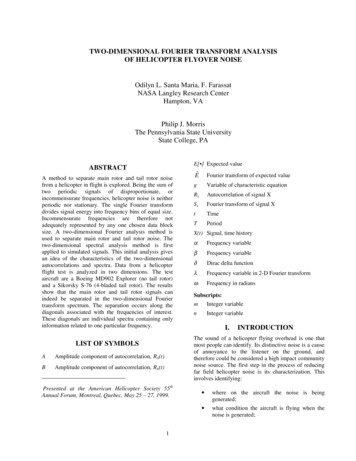
Transcription
The Strategy to Transform Health Careand The Role of OutcomesProfessor Michael E. PorterOECD Policy ForumPeople at the Center: The Future of HealthParis, Francewww.isc.hbs.eduJanuary 16, 2017No part of this publication may be reproduced, stored in a retrieval system, or transmitted in any form or by any means — electronic, mechanical, photocopying, recording, or otherwise — without the permissionof Michael E. Porter. For further references see www.isc.hbs.edu.1Copyright Michael Porter 2016
The Health Care Problem is a Global IssueHealth Care Spending vs GDP and IncomeIndex(1995 100)18.0% of GDP300HC SpendIncomeGDP2001001995200020052010 201310.9% of GDPIndex(1995 100)11.8% of GDPHC SpendGDPIncome1001995HC SpendGDPIncome200200020052010 2013200020052010 20139.7% of GDPIndex(1995 100)HC SpendIncomeGDP2001501001995Index(1995 100)11.5% of GDP2502002503001001995Index(1995 100)HC Spend200GDPIncome1501001995200020059.6% of GDPIndex(1995 100)400HC SpendIncomeGDP300200200020052010 2013Notes: Indexes based on local currencies; Income Personal Disposable Income; HC expenditures as % of GDP are OECD estimatesSource: Economist Intelligence Unit May 2014, BCG analysis22010 20131001995200020052010 2013Copyright Michael Porter 2016
Variation in Quality Within and Across Countries2xVariation in 30-day mortality rate from heart attack in US hospitals4xVariation in bypass surgery mortality in the UK hospitals5xVariation of major obstetrical complications among US hospitals9xVariation in Dutch hospitals’ complication rates from radical prostatectomiesin the Dutch hospitals18xVariation in reoperation rates after hip surgery in German hospitals20xVariation in mortality after colon cancer surgery in Swedish hospitalsVariation is pervasive across conditions and all types of outcomes whereversystematic data is available3Copyright Michael Porter 2016
Incremental “Solutions” Have Had Limited Impact Prior authorization for expensive services Patient copayments and deductions Electronic medical records Evidence-based medicine Safety/eliminating errors Introducing “lean” process improvements Care coordinators Retail and urgent care clinics Programs to address generic high cost areas(e.g. readmissions, post acute) Mergers and consolidation Restructuring health care delivery is necessary, not incremental improvements4Copyright Michael Porter 2016
Solving the Health Care Problem The fundamental goal and purpose of health care is to improvevalue for patientsValue Health outcomes that matter to patientsCosts of delivering these outcomes Delivering high value health care is the definition of success Value is the only goal that can unite the interests of systemparticipants Improving value is the only real solution The question is how to design health care delivery systems andorganizations that substantially improve patient value5Copyright Michael Porter 2016
Principles of Value-Based Health Care Delivery Value cannot be understood at the level of a hospital, specialty,intervention, or for overall primary care Value is created in caring for a patient’s medical condition overthe full cycle of careValue Set of outcomes that matter to patients for the conditionTotal costs of delivering them over the full care cycle In primary and preventive care, value is created in servingsegments of patients with similar primary and preventive needs The most powerful single lever for reducing cost and improvingvalue is improving outcomes6Copyright Michael Porter 2016
Creating Value-Based Health Care DeliveryThe Strategic Agenda1. Re-organize Care around Patient Conditions, into Integrated PracticeUnits For primary and preventive care, IPUs serve distinct patientsegments2. Measure Outcomes and Costs for Every Patient3. Move to Value-Based Reimbursement Models, and UltimatelyBundled Payments for Conditions4. Integrate Multi-Site Care Delivery Systems5. Expand or Affiliate Across Geography to Drive Excellence6. Build an Enabling Information Technology Platform7Copyright Michael Porter 2016
The Power of Outcome Measurement inValue-Based Health Care Outcomes are the most important information for patients Outcomes define success for every clinician and health careorganization Outcomes drive multidisciplinary care and care innovation Outcomes are essential components of any value-based paymentmodel Outcomes validate cost reduction that is truly value-enhancing Outcomes validate the areas for service line growth and affiliation8Copyright Michael Porter 2016
The Quality Measurement Patient InitialConditions,Risk omesE.g. PSA, Gleasonscore, surgical marginStructureE.g., Staff certification,facilities standards9Copyright Michael Porter 2016
The Outcome Measures HierarchyTier1Health StatusAchievedor RetainedSurvivalDegree of health/recovery Achieved clinical status Achieved functional status Time to diagnosis and treatmentTier2Process ofRecoveryTier3Sustainabilityof HealthSource: NEJM Dec 2010Time to recovery and return to normal activities Time to return home Time to return to normal activitiesDisutility of the care or treatment process (e.g., diagnostic errors andineffective care, treatment-related discomfort, complications, or adverseeffects, treatment errors and their consequences in terms of additionaltreatment)Sustainability of health/recovery and nature ofrecurrences Care-related pain/discomfort Complications Re-intervention/readmission Long-term clinical status Long-term functional statusLong-term consequences of therapy (e.g., care-inducedillnesses)10Copyright Michael Porter 2016
Measuring Multiple OutcomesProstate Cancer Care in GermanyAverage hospitalBest hospital94%5 year disease specific survival95%75.5%Severe erectile dysfunction after one year17.4%43.3%Incontinence after one year9.2%Source: ICHOM11Copyright Michael Porter 2016
Measuring Multiple OutcomesProstate Cancer Care in GermanyAverage hospitalBest hospital94%5 year disease specific survival95%75.5%Severe erectile dysfunction after one year17.4%43.3%Incontinence after one year9.2%Source: ICHOM12Copyright Michael Porter 2016
The International Consortium for Health OutcomesMeasurementOur mission:Unlock the potential of value-based health care by definingglobal Standard Sets of outcome measures that reallymatter to patients for the most relevant medical conditions,and driving adoption and reporting of these measuresworldwide13Copyright Michael Porter 2016
Standardizing Minimum Outcome SetsICHOM Standard SetsStandard SetsComplete(2014)Standard SetsComplete(2013)1.2.3.4.Localized Prostate Cancer *Lower Back Pain *Coronary Artery Disease *Cataracts *5.6.7.8.9.10.11.12.Standard SetsComplete(2015-16)Parkinson’s DiseaseCleft Lip and Palate*Stroke *Hip and Knee Osteoarthritis*Macular Degeneration*Lung Cancer*Depression and AnxietyAdvanced Prostate Cancer *13.14.15.16.17.18.19.20.21.Breast Cancer*DementiaFrail ElderlyHeart FailurePregnancy and ChildbirthColorectal CancerOveractive BladderCraniofacial MicrosomiaInflammatory Bowel DiseaseCommitted/In Process22.23.24.25.26.27.28.29.30.Chronic Kidney DiseaseOral HealthInflammatory ArthritisCongenital Hand and UpperLimb MalformationsFacial PalsyHypertension*DiabetesAtrial FibrillationMental Health* Published Thus Far in PeerReviewed JournalsBurden ofDiseaseCovered18%35%45%59%To learn more about ICHOM please visit us at www.ichom.org14Copyright Michael Porter 2016
Global Demand to Compare Outcomes is Accelerating15Copyright Michael Porter 2016
Transforming Health Care We know the path forward Value for patients is the True North Value-based thinking will revolutionize care delivery, payment,and strategy for health systems Standardized outcome measurement is the single mostpowerful driver ICHOM is honored to partner with the OECD to supporthealth ministers in accelerating this agenda16Copyright Michael Porter 2016
Jan 16, 2017 · of Michael E. Porter. For further references see www.isc.hbs.edu. Professor Michael E. Porter OECD Policy Forum People at the Center: The Future











